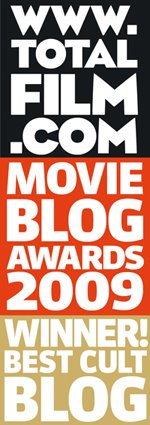The Blob, 1958, directed by Irwin S. Yeaworth, Jr., screenplay by Kate Phillips and Theodore Simonson, from an idea by Irvine Millgate.
It's an article of faith among film critics that the schlock sci-fi of the fifties can be mapped onto the fears of the era: Godzilla is about fear of the atomic bomb, Invasion of the Body Snatchers is about fear of conformity, and Forbidden Planet is about fear of Leslie Neilsen movies. So it's not too surprising that people look at The Blob and try to find a deeper subtext. Maybe it's about Communism. Or Korea. Or the Republican Party. Bruce Kawin makes the best guess, pinning the blame on post-war consumerism. You can make a case for that, and Kawin does, but I think it's probably apophenic to find too much deep cultural significance in a film that was inspired by the Sherwin Williams logo:

The Blob is, as Kawin notes, pretty unique among fifties movie monsters for being completely devoid of human characteristics. It's just exactly what you'd think it is from the title.

Found inside a crashed meteorite by a crazy hermit, the blob is a transparent goo that grows as it eats. And it eats people. It's a great idea that's kind of indifferently executed, because Yeaworth and company were as interested in making an antidote to teenage delinquency movies as they were interested in a monster movie. So for every scene of the blob creeping up behind an unsuspecting victim, you're guaranteed a scene of good-hearted teenagers trying to convince the town's authority figures that they're being honest about the monster they keep reporting. So why has the film outlived contemporaries like The Crawling Eye or The Giant Claw? I can answer that in three words:
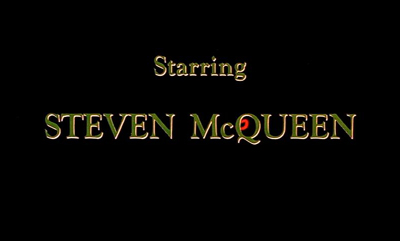
This was McQueen's first starring role in a feature, and not a moment too soon. He was 27 when this was filmed and looked every last day of it.
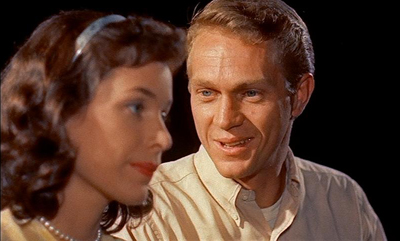
I'm more likely to believe that a semi-sentient man-eating gelatin could crash-land on earth than that McQueen or his co-star Aneta Corsaut are in high school. Maybe that's smart, in terms of distracting the audience from all of the film's other implausibilities, but this was not McQueen's finest hour. He hadn't really developed the persona that made him famous, and Bullit was years away. So The Blob is a rare opportunity to see one of the coolest movie stars in film history play a dork. We're talking shirt-tucked-in-no-belt, people.
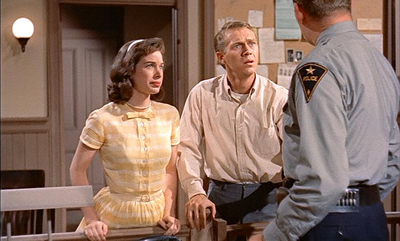
McQueen does an acceptable job of playing a guy who is not very cool by any modern standard, but he gets completely left in the dust by an actor named Kieth Almoney. Cast as Corsaut's younger brother, Almoney made the bold choice to portray him as the tragic victim of a brain parasite.

It's hard to choose a single favorite thing about Almoney's magical onscreen presence: when you deliver each line like Homestar Runner, everything you do makes an impression. His one-man toy pistol assault on the Blob is probably the high point.
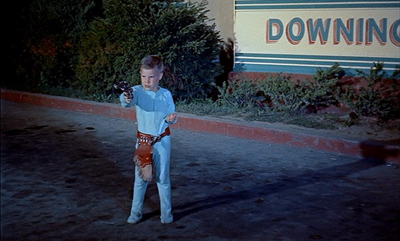
Almoney's performance betrays The Blob's origins; it was independently produced by a band of amateurs, far from Hollywood. Jack H. Harris was an independent distributor fed up with trying to sell poverty row Westerns to audiences who wanted Technicolor. He put the film together for virtually nothing at Valley Forge Studios in Pennsylvania, with a director and crew trained in producing religious shorts. Kate Philips had written for television, and Yeaworth mentions hiring an experienced editor after some false starts (although no one in the editorial department has previous credits on IMDB), but everyone else was brand new to the feature world. In fact, Kieth Almoney, like several other cast members and all of the extras, was recruited from Yeaworth's church. When something's that homegrown, it's easier to forgive things like the happy grins on the faces of the crowd fleeing the Colonial Theater in terror: they're gonna be in the movies.

As far as casting the main roles goes, Harris made the financially smart decision to shell out for experienced actors in minor roles, while giving the leads to cheaper unknowns. Of course, when you luck into hiring Steve McQueen as an unknown (and pay him all of $3,000), the success of your film doesn't really depend on the audience finding Alden Chase's face reassuringly familiar.

Harris's modest goal with The Blob was the same as every scrub at Sundance: get studio distribution. Fortunately, Paramount needed something to fill out the bottom of a double bill with I Married A Monster From Outer Space, so Harris got his wish. Yeaworth and some of the other crew seem to have believed they'd made a work of gothic horror, but the Paramount executives knew what they'd bought: the first thing they did was cut the ominous opening-credits music (over Saul-Bass inspired titles) and replace it with a novelty single called "Beware of the Blob," written by Burt Bacharach and Hal David. The single charted in Los Angeles, Carson made a joke about it on-the-air, Paramount gave The Blob top billing (and re-released it once McQueen was a star), and there's no Criterion edition of I Married a Monster from Outer Space. Maybe there should be.
Randoms:
- This is probably the only Criterion Collection DVD to use the word "superstud" on the back of the DVD case. The exact usage ("THE BLOB helped launch the careers of superstud Steve McQueen and composer Bert Bacharach") should piss off composers and Burt Bacharach fans everywhere.
- Superstud or no, McQueen was apparently impossible to deal with on set. Harris talks on the commentary track about having to drive from Philadelphia to the set several times to coax him back on set. Smoke drifts up incongruously over his shoulder in one shot because he wouldn't put out his cigarette while filming a close-up. He apparently borrowed Yeaworth's car (the only new car he ever owned), drove it to New York City, and returned it with unexplained scratches all over the roof. His behavior was abysmal enough that Harris, who'd signed him for a three-picture deal, released him completely.
- Many of the minor roles were cast from the performers of the Hedgerow Theatre, a repertory group based in nearby Rose Valley. The company's founder, Jasper Deeter, has one of the only funny-on-its-own-terms scenes in the film, as an aged Civil Defense volunteer and volunteer fireman who can't decide which helmet is best suited for Blob-fighting.
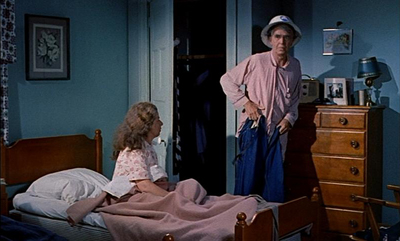
- Among all the inappropriately smiling extras, the gentleman in the checked shirt in this still clearly deserves some recognition for his performance. He's not only the only extra who looks unhappy, he genuinely looks horrified.
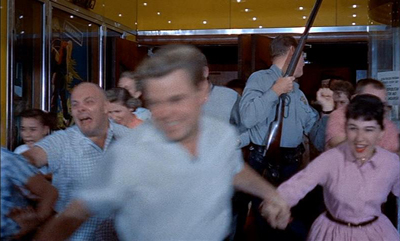
- Robert Fields, who went on to a distinguished film career of his own, contributes a pretty amusing commentary track. He would have been 19 when this was shot, and basically remembers it as "the summer I hung out with Steve McQueen and unsuccessfully tried to score with one of the actresses." Actors usually talk about their jobs at a certain remove, but Fields sounds like anyone else seeing footage of their summer job when they were 19: he remembers virtually all of it in terms of personal relationships, and clearly the experience of being rejected that summer still burns him a little. On the other hand, though he doesn't remember her name (I would bet it's Molly Anne Bourne or Diane Tabben, both of whom are credited as "Teenager" on the IMDB) he does remember that she was engaged, so it's probably for the best. Here she is, sitting next to him in pink:

- Most of the effects shots depend on plywood constructions with forced-perspective scenery, like this:
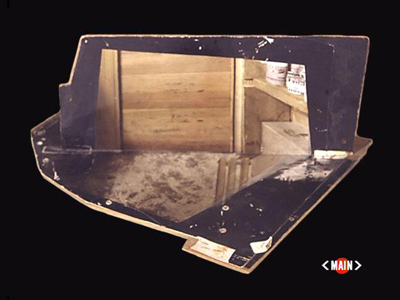
- The Blob (colored silicone, in its pre-implant days) would then roll toward the camera when the set was tilted. When it works, the effect looks fine, but when anything's wrong with the perspective, things go very badly. Take a look at the M. C. Escher inspired angle on the diner stool:
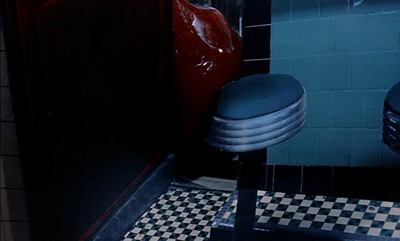
- For shots that wouldn't work with forced-perspective models, the filmmakers used rotoscoping, and sometimes resorted to straight cell-animation. This is about as convincing as you might imagine:

- That said, there's a single shot of the teenagers looking at the Blob enveloping the Downingtown Diner that goes right around past bad to good and ends up looking like something Miguel Calderón would hire someone else to paint:
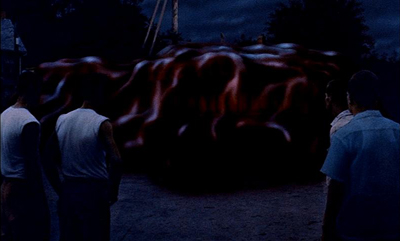
- I would absolutely buy the original.
- The DVD includes images of posters for the film from various releases and rereleases. Most use some variation of the original key art:

- Say what you will about the art style, you know what you're getting. And then there's the French. One thing to remember about The Blob is that McQueen is never shirtless in the film. What's more, since it was made in 1958, there aren't any cars from the mid-60's in it. Nor are there helicopters. Or skyscrapers. And McQueen's costar is a brunette, not a shotgun-wielding blonde. So the French poster might lead you to draw some incorrect conclusions:
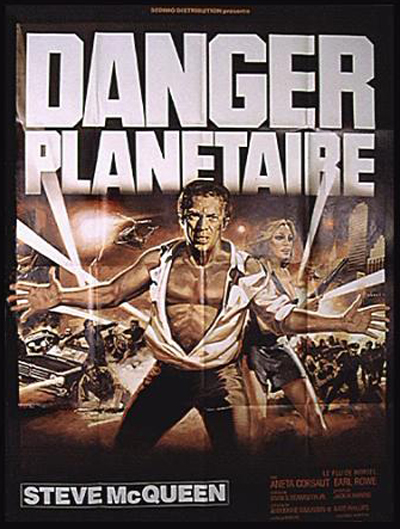
- Ah, La France! If Danger Planetaire existed, I'd watch it more often than The Blob.

